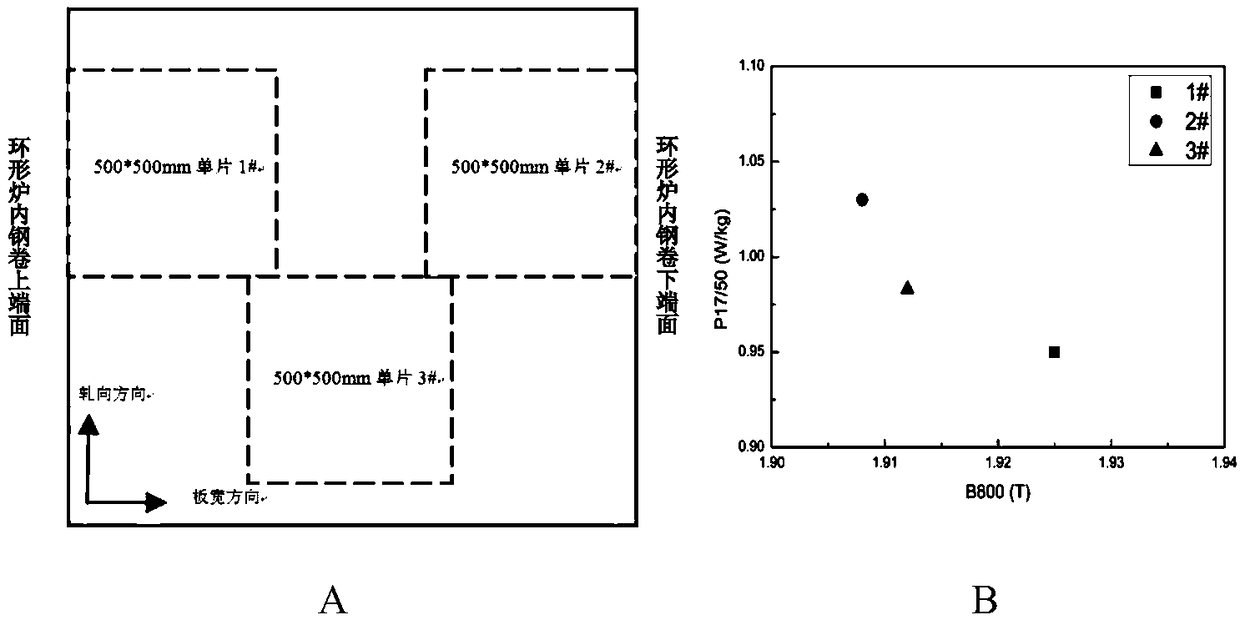Production method of low temperature and high magnetic induction oriented silicon steel for improving magnetic uniformity in direction of plate width
A technology of high magnetic induction orientation and production method, which is applied in the direction of coating, metal material coating process, solid-state diffusion coating, etc., can solve the problems of uneven magnetic properties of steel coils, improve the magnetic level, solve magnetic unevenness, and improve Overall magnetic effect
- Summary
- Abstract
- Description
- Claims
- Application Information
AI Technical Summary
Problems solved by technology
Method used
Image
Examples
Embodiment 1
[0060] Embodiment 1 and comparative example 1 are all produced according to the following steps (nitriding in the decarburization annealing is carried out by different processes):
[0061] 1) The slab is obtained after smelting, vacuum and continuous casting; during the production process, the steel composition is shown in Table 1:
[0062] The chemical composition (wt%) of table 1 slab, balance is Fe
[0063] element
C
Si
mn
S
Cu
als
Cr
N
Embodiment 1 / Comparative Example 1
0.057
2.9
0.08
0.005
0.06
0.0273
0.11
0.0061
[0064] 2) Hot rolling: the heating temperature is 1150°C; the final rolling temperature is 950°C;
[0065] 3) Pickling normalization: adopt conventional two-stage normalization annealing, the temperature of the first stage of normalization is 1100°C, and the temperature of the second stage is 920°C;
[0066] 4) Cold rolling: the cold rolling aging temperature is 220°C, and the thickness ...
Embodiment 2
[0080] Embodiment 2 and comparative example 2 are all produced according to the following steps (nitriding in the decarburization annealing is carried out by different processes):
[0081] 1) The slab is obtained after smelting, vacuum and continuous casting; during the production process, the steel composition is shown in Table 3:
[0082] The chemical composition (wt%) of table 3 billet, balance is Fe
[0083]
[0084] 2) Hot rolling: the heating temperature is 1180°C; the final rolling temperature is 960°C;
[0085] 3) Pickling normalization: adopt conventional two-stage normalization annealing, the temperature of the first stage of normalization is 1100°C, and the temperature of the second stage is 900°C;
[0086] 4) Cold rolling: the cold rolling aging temperature is 214°C, and the thickness of the cold rolled finished product is 0.23mm;
[0087] 5) Continuous annealing and nitriding: according to different processes:
[0088] Example 2: a. During the decarburizatio...
Embodiment 3
[0099] Embodiment 3 and comparative example 3 are all produced according to the following steps (nitriding in the decarburization annealing is carried out by different processes):
[0100] 1) The slab is obtained after smelting, vacuum and continuous casting; during the production process, the steel composition is shown in Table 5:
[0101] The chemical composition (wt%) of table 5 billet, balance is Fe
[0102]
[0103] 2) Hot rolling: the heating temperature is 1200°C; the final rolling temperature is 970°C;
[0104] 3) Pickling normalization: adopt conventional two-stage normalization annealing, the temperature of the first stage of normalization is 1150°C, and the temperature of the second stage is 950°C;
[0105] 4) Cold rolling: the cold rolling aging temperature is 224°C, and the thickness of the cold rolled finished product is 0.20mm;
[0106] 5) Continuous annealing and nitriding: according to different processes:
[0107] Example 3: a. During the decarburizatio...
PUM
| Property | Measurement | Unit |
|---|---|---|
| thickness | aaaaa | aaaaa |
| particle size | aaaaa | aaaaa |
Abstract
Description
Claims
Application Information
 Login to View More
Login to View More - R&D Engineer
- R&D Manager
- IP Professional
- Industry Leading Data Capabilities
- Powerful AI technology
- Patent DNA Extraction
Browse by: Latest US Patents, China's latest patents, Technical Efficacy Thesaurus, Application Domain, Technology Topic, Popular Technical Reports.
© 2024 PatSnap. All rights reserved.Legal|Privacy policy|Modern Slavery Act Transparency Statement|Sitemap|About US| Contact US: help@patsnap.com










